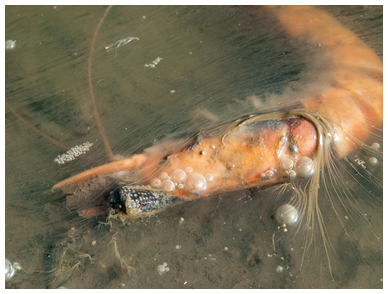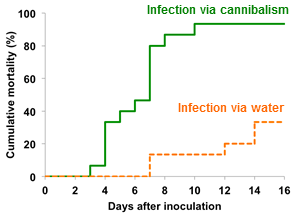Spread of infection of yellow head virus (YHV) of giant tiger prawns by cannibalism
Description
Intensive Penaeidae cultivation is an important industry supporting the economy in tropical regions. However, due to recent disease outbreaks and their frequency (Fig. 1), the production in cultivation farms has become unstable and as such, a prompt solution is critical. In South-East Asia, yellow head virus (YHV) is a commonly occurring viral infection in shrimp. Since the first reports of YHV in Thailand, the virus continues to cause serious damage in various places. However, the transmission mechanism of the virus is still unclear. Shrimp farmers exchange the cultivation water as seldom as possible to avoid lateral infection which in turn results in water quality deterioration and reduced productivity. In this study, we carried out experiments in order to understand the mechanisms of YHV transmission and propose measures to reduce the impact of infections.
Amongst an experimental group allowed to cannibalize infected shrimp, more than 90% of all shrimp died from severe infection within 10 days (Fig. 2, Table 1). On the other hand, significantly lower rates of YHV detection and severity were identified amongst another group sharing the aquarium water with the cannibals but separated by a filter and the death rate was also significantly lower (Fig. 2, Table 1). Moreover, the YHV severity of shrimp in the second group that had survived low level infections gradually reduced after 30 days to 60 days (Table 1). These results show that YHV infection in shrimp is more severe if the infection was caused by cannibalism than by water. The gills from shrimp that had died from YHV were collected, homogenated, and filtered at 12 and 24 hours post-mortem respectively and injected into the muscle of healthy individuals. Those injected with gills collected 12 hours post death all died within 4 days. On the other hand, only one among those injected with gills collected 24 hours post death died after 7 days (Table 2). YHV activity is still high 12 hours post-mortem but significantly reduces after 24 hours. In shrimp cultivation, the possibility of YHV infection via pond water is low; therefore, avoiding water exchange is not necessary. Furthermore, it is more important to reduce the incidence of healthy individuals feeding (cannibalizing) on other shrimp that have died from YHV infection. For example, prompt collection of deceased individuals and low-density production would be effective measures against YHV infection.
Appropriate water exchange will enhance the water quality, which in turn will enhance the expected recovery of individuals with low level infections. Greater results could be anticipated by introducing and implementing specific pathogen-free (SPF) juvenile shrimp. The mechanism of the first occurrence of YHV infection in shrimp cultivation ponds is still unknown; hence, further studies are required for a detailed understanding of YHV infection.
Figure, table
-
Fig. 1. Giant tiger prawn infected with YHV at an earthen shrimp pond
-
Fig. 2. Cumulative mortalities during a 16-day experiment between infected aquariums (through cannibalization and water borne routes)
-
Table 1. Number of deceased/surviving individuals and their infection intensity (infection through cannibalization and waterborne routes)
Infection via cannibalismInfection via waterSeverely infectedSlightly infectedUndetectableTotalSeverely infectedSlightly infectedUndetectableTotalNumber of deaths1400140325Survivors (30 days later)001105510(60 days later)001102810 -
Table 2. Gills from individuals that had died from YHV infection were collected at 12 and 24 hours post-mortem, and the homogenate was injected into the muscle of eight healthy individuals. The number of dead/surviving individuals and their infection intensity was recorded.
12 hours later24 hours laterSeverely infectedSlightly infectedUndetectableTotalSeverely infectedSlightly infectedUndetectableTotalNumber of deaths80081001Survivors00000257
- Affiliation
-
Japan International Research Center for Agricultural Sciences Fisheries Division
- Research project
- Program name
- Term of research
-
FY2016(FY2011~FY2015)
- Responsible researcher
-
Tsutsui Isao ( Fisheries Division )
KAKEN Researcher No.: 80425529Hamano Kaoru ( Japan Fisheries Research and Education Agency )
KAKEN Researcher No.: 40371827Aue-umneoy Dusit ( King Mongkut's Institute of Technology Ladkrabang )
- ほか
- Publication, etc.
-
https://doi.org/10.1016/j.aquaculture.2014.11.038
Hamano K et al. (2015) Aquaculture, 437:161–166
- Japanese PDF
-
A4 491.09 KB
A3 347.98 KB
- English PDF
-
A4 588.21 KB
A3 642.58 KB
- Poster PDF
-
Poster 343.81 KB


